CRL: Conservation Projects - Invasive Species
Differential Response of a Native Arizona Gray Squirrel and an Introduced Abert’s Squirrel to a Mosaic of Burn Severities
-
Time Period: August 2011-Present
-
Student: Shari Ketcham
-
Location: Santa Catalina Mountains, AZ, U.S.A.
-
 Major Questions: What burn severities do tree squirrels use post fire regarding resources such as dreys, cavities, and food? How large are the patch sizes of the burn severities that tree squirrels choose to use? Are there any competition factors between tree squirrels for resources post fire? If so, what resources do tree squirrels compete for? What is the estimated abundance and distribution of tree squirrels on the Santa Catalina Mountains?
Major Questions: What burn severities do tree squirrels use post fire regarding resources such as dreys, cavities, and food? How large are the patch sizes of the burn severities that tree squirrels choose to use? Are there any competition factors between tree squirrels for resources post fire? If so, what resources do tree squirrels compete for? What is the estimated abundance and distribution of tree squirrels on the Santa Catalina Mountains?

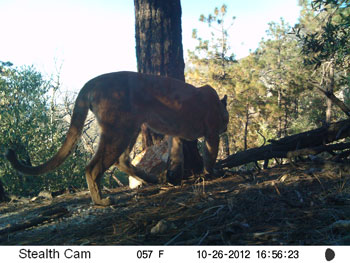
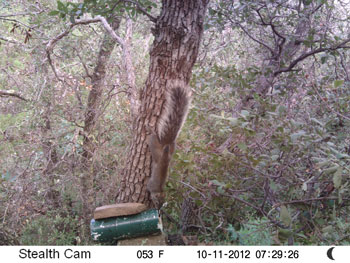
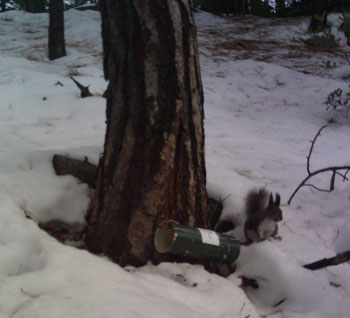
-
Major Findings: NA-Research in Progress
Project Details (click to expand/reduce)
Competition between native and introduced species
-
Time period: August 2010 – present
-
Student: Jonathan J. Derbridge
-
Location: Pinaleño Mountains, Arizona, USA
-
 Major Questions: I am studying mechanisms of competition between native and introduced species. Exploitation competition occurs when individuals have indirect negative effects on other individuals by restricting access to a common resource. Competition from introduced species for common food resources may force native species to forage more widely, and consume sub-optimal diets. Isolated populations of territorial species may, over time, become less adept at excluding ecologically similar competitors. I am using experimental removals of introduced Abert’s squirrels (Sciurus aberti) to test hypotheses on the impacts of dietary and spatial overlap with the Mount Graham red squirrel (Tamiasciurus hudsonicus grahamensis). I am also conducting tests of exploitation competition that relate to the relative abilities of an invader to succeed, and a native species to maintain its advantage. These tests include examining how Abert’s squirrels may take advantage of larder-hoarding by red squirrels, and comparing territorial behavior of Mount Graham red squirrels with individuals in other red squirrel populations.
Major Questions: I am studying mechanisms of competition between native and introduced species. Exploitation competition occurs when individuals have indirect negative effects on other individuals by restricting access to a common resource. Competition from introduced species for common food resources may force native species to forage more widely, and consume sub-optimal diets. Isolated populations of territorial species may, over time, become less adept at excluding ecologically similar competitors. I am using experimental removals of introduced Abert’s squirrels (Sciurus aberti) to test hypotheses on the impacts of dietary and spatial overlap with the Mount Graham red squirrel (Tamiasciurus hudsonicus grahamensis). I am also conducting tests of exploitation competition that relate to the relative abilities of an invader to succeed, and a native species to maintain its advantage. These tests include examining how Abert’s squirrels may take advantage of larder-hoarding by red squirrels, and comparing territorial behavior of Mount Graham red squirrels with individuals in other red squirrel populations. 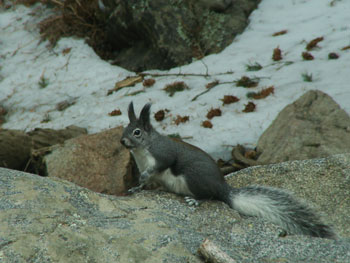
-
Research Questions: What are the impacts of dietary overlap between native and introduced species occupying similar niches? Does syntopy with an introduced species incur fitness costs associated with changes in home range size and composition for native species? Do introduced non-hoarding species compete with larder-hoarding native species through kleptoparasitism? Does isolation from interspecific competition lead to weakening of territorial behavior and facilitate successful invasions?
Project Details (click to expand/reduce)
Road and traffic effects on movements and space use of red squirrels
-
Time Period: 2009 - present
-
Student: Hsiang Ling Chen
-
Location: Mt. Graham, AZ, U.S.A.
-
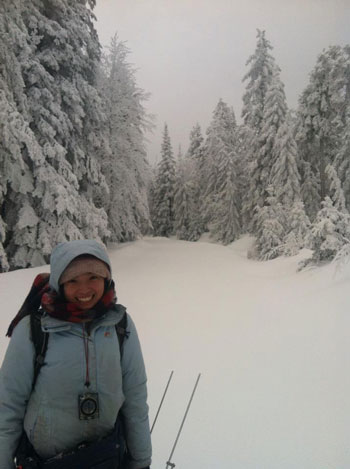 Road ecology is a burgeoning field of inquiry as roadways expand in number, length and width. We know that roads fragment habitats, increase mortality, change microclimates, and can act as barriers…thus they present a challenge in the conservation of biodiversity. Roads may function as impermeable barriers to some species while being semi-permeable to others. We are examining the relative permeability of roads to two species in the Pinaleno Mountains of southeastern Arizona: federally endangered Mt. Graham red squirrels (Tamiasciurus hudsonicus grahamensis) and non-native Aberts squirrels (Sciurus aberti).
Road ecology is a burgeoning field of inquiry as roadways expand in number, length and width. We know that roads fragment habitats, increase mortality, change microclimates, and can act as barriers…thus they present a challenge in the conservation of biodiversity. Roads may function as impermeable barriers to some species while being semi-permeable to others. We are examining the relative permeability of roads to two species in the Pinaleno Mountains of southeastern Arizona: federally endangered Mt. Graham red squirrels (Tamiasciurus hudsonicus grahamensis) and non-native Aberts squirrels (Sciurus aberti). -
Major Questions: Do red squirrels avoid roads? If so, what factors are most influential to avoidance? Do they avoid forest edges created by roads, forest gaps, or traffic disturbances?
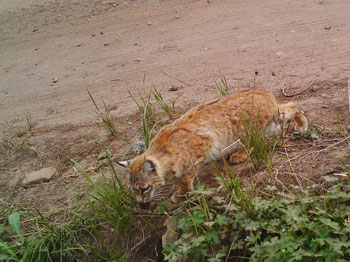
Project Details (click to expand/reduce)
Competition for conifer cones as a potential mechanism of endangerment for the Mt. Graham red squirrel.
-
Time Period: 2007 - 2010
-
Student: Rebecca Minor
-
Location: Pinaleño (Graham) Mountains, Graham County, southeastern Arizona (Coronado National Forest).
-
 Major Questions/Objectives: Non-native species are a major cause of endangerment for native species, but the mechanisms are often unclear. The sky island region of the southwestern US and northwestern Mexico supports many isolated endemic species that are restricted to high elevation forests and vulnerable to species invasions. One such range, the Pinaleño Mountains in southeastern Arizona, supports the entire population of the critically endangered Mount Graham red squirrel (Tamiasciurus hudsonicus grahamensis) (MGRS). A second tree species, the Abert’s squirrel (Sciurus aberti) was introduced to the range in 1941 by Arizona Game and Fish Department for increased recreational hunting opportunities.
Our field experiment quantified the impact of introduced Abert's squirrels on rates of food removal within the range of the MGRS. We placed single cones on 4m x 4m plots (1m spacing) at random locations in the forest and observed the rate of removal by both species of squirrel through direct observation and remote cameras. Then Abert’s squirrels were excluded from cone removal by placing cones in wire mesh tubes that were of small diameter, so that only MGRS could enter. burn severity? Does the landscape pattern (patchiness) of burn severity affect squirrel habitat use?
Major Questions/Objectives: Non-native species are a major cause of endangerment for native species, but the mechanisms are often unclear. The sky island region of the southwestern US and northwestern Mexico supports many isolated endemic species that are restricted to high elevation forests and vulnerable to species invasions. One such range, the Pinaleño Mountains in southeastern Arizona, supports the entire population of the critically endangered Mount Graham red squirrel (Tamiasciurus hudsonicus grahamensis) (MGRS). A second tree species, the Abert’s squirrel (Sciurus aberti) was introduced to the range in 1941 by Arizona Game and Fish Department for increased recreational hunting opportunities.
Our field experiment quantified the impact of introduced Abert's squirrels on rates of food removal within the range of the MGRS. We placed single cones on 4m x 4m plots (1m spacing) at random locations in the forest and observed the rate of removal by both species of squirrel through direct observation and remote cameras. Then Abert’s squirrels were excluded from cone removal by placing cones in wire mesh tubes that were of small diameter, so that only MGRS could enter. burn severity? Does the landscape pattern (patchiness) of burn severity affect squirrel habitat use? -
Major Findings: In the presence of Abert's squirrels, the time until 50% of cones were removed was significantly faster than when Abert's squirrels were excluded. The impact on food availability as a result of cone removal by Abert's squirrels suggests the potential of food competition as a mechanism of endangerment for the Mount Graham red squirrel. We suggest that a successful management approach for MGRS with target the impact of Abert’s squirrels on food availability. That a large proportion of cones available to both MGRS and Abert’s squirrels were removed before cones available only to MGRS suggests the importance of considering removal of the introduced Abert’s squirrel as a priority in conserving red squirrels in the Pinaleño Mountains.
Project Details (click to expand/reduce)



Assessment of an introduced population of Mexican red-bellied squirrels (Sciurus aureogaster) in Biscayne National Park, Florida, USA
-
Time Period: 2006-2007
-
Student: Geoffrey Palmer
-
Location: Biscayne National Park, FL, U.S.A.
-
 Major Questions: What is the current status and distribution of an introduced population of Mexican red-bellied squirrels (Sciurus aureogaster)? What is the nesting behavior and habitat use of red-bellied squirrels in a novel environment? What impacts is the squirrel having in the National Park? What potential impacts could this species have if it continues to spread?
Major Questions: What is the current status and distribution of an introduced population of Mexican red-bellied squirrels (Sciurus aureogaster)? What is the nesting behavior and habitat use of red-bellied squirrels in a novel environment? What impacts is the squirrel having in the National Park? What potential impacts could this species have if it continues to spread? -
Major Findings: Red-bellied squirrels were found throughout the mixed-hardwood forest of Elliott Key. Evidence of squirrels was found on Sands Key to the north and on Old Rhodes Key to the south. No evidence of squirrels was found on Adam’s Key. Red-bellied squirrels built nests in larger, taller trees than randomly available in the forest, with nests most often built on the north side of the nest tree. Nest trees had more access routes and
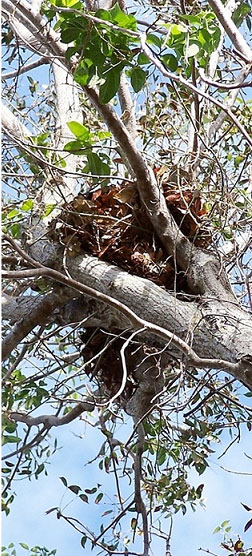 more trees immediately surrounding the nest tree than random trees. Habitat plots around nest trees had higher canopy cover, basal area, and numbers of live trees; but lower recent hurricane damage, and fewer shrub stems. Overall, red-bellied squirrels introduced to Elliott Key exhibit similar nest site selection behavior to squirrels in their native range and to other tree squirrels.
Although nests were only found in mixed-hardwood forest, there was evidence that squirrels forage and collect nesting materials in mangrove and buttonwood forests. Squirrels relied on a number of native plants for food, and during the dry months of January-March, they clipped branch tips and damaged a number of trees. We recorded some evidence that squirrels utilized Florida tree snails (Liguus sp.), a species of conservation concern, as a food source. Potential impacts from spread include competition with a number of federally endangered rodents: Key Largo woodrat, Key Largo cotton mouse, and Big Cypress fox squirrel.
more trees immediately surrounding the nest tree than random trees. Habitat plots around nest trees had higher canopy cover, basal area, and numbers of live trees; but lower recent hurricane damage, and fewer shrub stems. Overall, red-bellied squirrels introduced to Elliott Key exhibit similar nest site selection behavior to squirrels in their native range and to other tree squirrels.
Although nests were only found in mixed-hardwood forest, there was evidence that squirrels forage and collect nesting materials in mangrove and buttonwood forests. Squirrels relied on a number of native plants for food, and during the dry months of January-March, they clipped branch tips and damaged a number of trees. We recorded some evidence that squirrels utilized Florida tree snails (Liguus sp.), a species of conservation concern, as a food source. Potential impacts from spread include competition with a number of federally endangered rodents: Key Largo woodrat, Key Largo cotton mouse, and Big Cypress fox squirrel. -
Our work documenting the threat of spread beyond the borders of Biscayne National Park and the potential impacts squirrels could have on native species led to the decision to attempt an eradication of the species. The National Park Service hopes to complete the eradication in 2013.
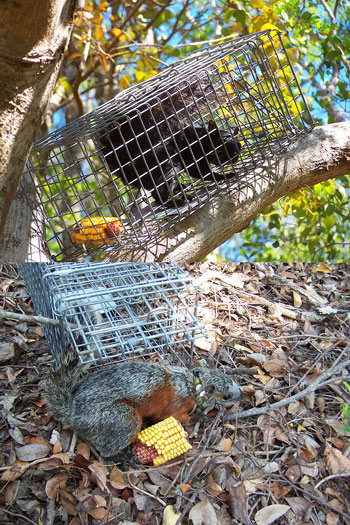
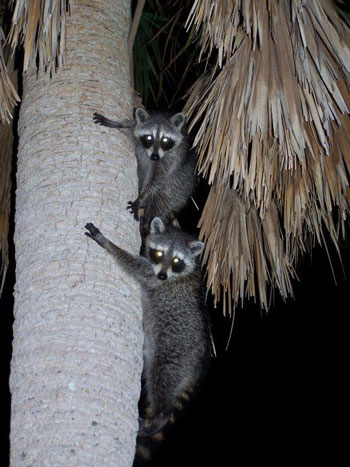
Project Details (click to expand/reduce)
Differential response to fire by an exotic and an endemic species complicate endangered species conservation
-
Time Period: May 2006 to Oct 2007
-
Student: Nate Gwinn
-
Location: Mount Graham (Pinaleño Mountains), Graham County, Arizona, USA
-
 Major Questions: The Nuttall Complex fire burned ~ 12029 ha in the Pinaleño Mountains of southeastern Arizona in summer 2004, including large areas of the upper elevation mixed conifer and spruce fir forests. Historically, mixed conifer forests in the Pinaleños experienced a low severity fire every 4 to 6 years, and spruce-fir forests experienced infrequent stand-replacement burns every 300 years. To investigate the effect of wildfire on exotic and introduced species, we looked at the differential use of burned and unburned areas by introduced Abert’s squirrels and the endemic and critically endangered Mount Graham red squirrel in the Pinaleños. We assessed effects of wildfire on habitat use of introduced Abert’s squirrels and native red squirrels by sampling species-specific feeding sign and employing radiotelemetry to reveal use of burned and unburned areas by both species. We document differential use of fire-impacted habitats that favors the introduced species thus complicating traditional conservation efforts used in forested environments.
Major Questions: The Nuttall Complex fire burned ~ 12029 ha in the Pinaleño Mountains of southeastern Arizona in summer 2004, including large areas of the upper elevation mixed conifer and spruce fir forests. Historically, mixed conifer forests in the Pinaleños experienced a low severity fire every 4 to 6 years, and spruce-fir forests experienced infrequent stand-replacement burns every 300 years. To investigate the effect of wildfire on exotic and introduced species, we looked at the differential use of burned and unburned areas by introduced Abert’s squirrels and the endemic and critically endangered Mount Graham red squirrel in the Pinaleños. We assessed effects of wildfire on habitat use of introduced Abert’s squirrels and native red squirrels by sampling species-specific feeding sign and employing radiotelemetry to reveal use of burned and unburned areas by both species. We document differential use of fire-impacted habitats that favors the introduced species thus complicating traditional conservation efforts used in forested environments. -
Major Findings: Our study is the first to document the positive response of an exotic mammal and negative response of the native species to wildfire and suggests that fire must be used judiciously as a restoration tool. Abert’s squirrels thrive in mixed conifer forest, our study documented that Abert’s squirrels fed, moved and nested within mixed conifer forest affected by wildfire. Home ranges of Abert’s squirrels were smaller in burned than in unburned forest. This suggests that habitat created by wildfire was of higher quality than unburned areas. Abert’s squirrels selected sites that had more live trees, less logs, and higher canopy closure than random sites within the burned area, similar to characteristics of mature ponderosa pine forests that Abert’s squirrels prefer in native range. These characteristics include high basal area, mature trees with interlocking crowns, and an understory with little down and woody debris. Transect data on feeding sign also indicated that Abert’s squirrels remained in burned areas. In effect, wildfire may be improving habitat for Abert’s squirrels in mixed conifer forest by creating preferred structure.
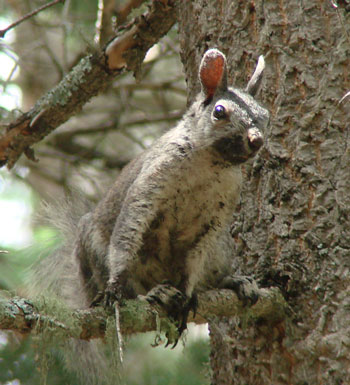
Project Details (click to expand/reduce)

The ecology of an introduced population of Abert’s squirrels in a mixed-conifer forest.
-
Time Period: 2001 - 2004
-
Student: Andrew J. Edelman
-
Location: Pinaleño (Graham) Mountains, Graham County, southeastern Arizona (Coronado National Forest).
-
 Major Questions/Objectives: Abert’s squirrels (Sciurus aberti) are reported to depend on ponderosa pine (Pinus ponderosa) for food and nest sites. Introduced Abert’s squirrels in the Pinaleño Mountains of Arizona, however, occupy mixed-conifer forests that contain almost no ponderosa pine (about 2%). We examined Abert’s squirrel nest site selection, diet, and home range in this novel habitat.
In addition, we examined the potential for interspecific competition for nest sites and food resources between co-occurring native Mt. Graham red squirrels (Tamiasciurus hudsonicus grahamensis) and non-native Abert’s squirrels in the Pinaleño Mountains.
Major Questions/Objectives: Abert’s squirrels (Sciurus aberti) are reported to depend on ponderosa pine (Pinus ponderosa) for food and nest sites. Introduced Abert’s squirrels in the Pinaleño Mountains of Arizona, however, occupy mixed-conifer forests that contain almost no ponderosa pine (about 2%). We examined Abert’s squirrel nest site selection, diet, and home range in this novel habitat.
In addition, we examined the potential for interspecific competition for nest sites and food resources between co-occurring native Mt. Graham red squirrels (Tamiasciurus hudsonicus grahamensis) and non-native Abert’s squirrels in the Pinaleño Mountains. -
Major Findings: Abert’s squirrel dreys (i.e., spherical nests) were built adjacent to the trunk at 75% of the tree height. Dreys were found in 5 different conifer species and 2% were in ponderosa pine. Drey trees were larger and had more access routes than did random trees. The structural characteristics of drey trees in the Pinaleños population also were very similar to drey trees used by natural populations of Abert’s squirrels in ponderosa pine forests. Structural features such as tree size and access routes appear to be more important to selection of drey sites than tree species.
-
Through observations of marked animals, we found that individuals in the mixed-conifer forest ate similar food items as Abert’s squirrels in ponderosa pine forests, including seeds, inner bark, buds, and fungi, but 5 conifer species were used as food sources. Douglas-fir (Pseudotsuga menziesii) and southwestern white pine (Pinus strobiformis) were the most frequently eaten conifer species. Nests of Abert’s squirrels also were detected in all tree species. Our results for nest site selection and food suggest that the dependence of Abert’s squirrels on ponderosa pine is not as strong as previously reported.
-
Abert’s squirrel home-range size, home-range overlap with females, and movement distances increased for males from nonmating to mating seasons. Home-range size and overlap characteristics of females remained consistent between seasons, but movement distances were reduced during the mating season. Non-mating season home ranges in our study were smaller than home ranges observed in ponderosa pine forest. Abert’s squirrels in mixed-conifer forest may have small home ranges because resource quality is higher than in ponderosa pine forest or due to competition for space with co-occurring Mount Graham red squirrels.
-
Comparison of nest use between Mt. Graham red squirrels and Abert’s squirrels at different scales (nest, nest tree, and nest site) revealed contrasting results. Competition for nests and nest trees appears unlikely given the dissimilarity in use of nest types and tree characteristics. Abert’s squirrels predominately used dreys, whereas red squirrels mostly used cavity nests. Neither squirrel species occupied a nest used by the other species. Abert’s squirrel nest sites were found in a wider range of microhabitats including almost all microhabitats in which red squirrel nest sites were located. Although there was significant overlap, each species showed distinct trends in microhabitat. In general, red squirrel nest sites were characterized as more densely forested areas dominated by corkbark fir (Abies lasiocarpa var. arizonica), whereas Abert’s squirrel nest sites were more open and contained greater tree species diversity. Overlap in microhabitat characteristics increases the likelihood of interspecific competition and could increase the vulnerability of red squirrels to extinction.
-
We also used remote photography to assess the frequency of inter- and intra-specific kleptoparasitism and species richness at Mt. Graham red squirrel middens. Remote cameras and conifer cones were placed at occupied and unoccupied middens, and random sites. Species richness of small mammals was higher at red squirrel middens than random sites. Abert’s squirrels, potential kleptoparasites, were recorded only at unoccupied middens and random sites. Non-resident red squirrels were most common at unoccupied middens and rare at occupied middens and random sites. Inter- and intra-specific kleptoparasitism of red squirrel middens appears uncommon likely due to territorial behavior.
Project Details (click to expand/reduce)

